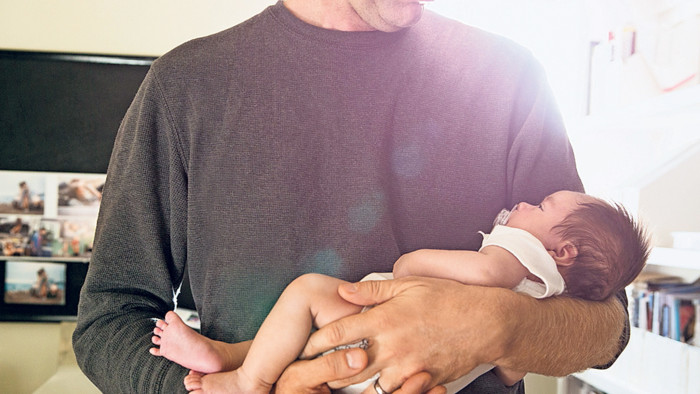Time off for new fathers raises bias awareness

Roula Khalaf, Editor of the FT, selects her favourite stories in this weekly newsletter.
When Fahad Sayood found out in late 2017 that he would be eligible to take six months’ leave, at full pay, after the birth of his second child, he was thrilled.
“It blew my mind,” he says. “The opportunity to spend that time with my family for a full six months, and then come back and pick up where I left off, was incredible.”
Mr Sayood is head of financial risk at Aviva, one of the UK’s biggest insurers. Just over a year ago, the company introduced a worldwide “equal parental leave” policy, under which all new parents, male and female, can take up to a year off after the birth or adoption of a child, including 26 weeks at full basic pay.
In the UK, where Mr Sayood is based, fathers typically are entitled to two weeks of paternity leave, while mothers can take up to 52 weeks of statutory maternity leave. Since 2015 parents have also been able to take advantage of shared parental leave, which allows mothers to transfer some of their leave to fathers. However, only 2 per cent of eligible parents have used the scheme.
Aviva says new fathers took an average of 21 weeks’ paternity leave in the year after it introduced the policy, compared with two weeks the year before. Stuart Mitchell, a security controls tester at Aviva, who also took six months’ leave after the birth of his son, says he would do so again — it gave him a “real chance” to bond with his son while his partner returned to work.
According to OECD research from 2013, fathers who take more paternity leave are more involved during infancy and throughout childhood than those who do not. A separate 2015 study of Quebec’s non-transferable paternity leave policy, or “daddy quota”, found that fathers who took paternity leave were likely to share childcare and household responsibilities more equitably with their female partners.
The Quebec study also said mothers whose spouses took advantage of the policy “spent more time in paid work, spent more time physically at the workplace and were more likely to be full-time employed”.
A Swedish study published in 2010 found that each month a father stays on parental leave increases a mother’s earnings. This led researchers to conclude that a lack of fathers’ involvement in childcare and parental leave “could be one factor” behind the gender pay gap.
Caroline Prendergast, chief people officer at Aviva, says the insurer “wanted to create a level playing field for men and women taking time out of their careers” with its equal parental leave policy. Over time, the policy should “reduce the opportunity for bias which sometimes occurs in recruitment and promoting talent, particularly [for] women”, she says.
“What we have noticed with men who are taking paternity leave, by asking the same questions that women tend to ask, they are getting to understand what it feels like,” she says. “The simple thought process of going through those questions will help reduce bias when people go on leave for a period of time.”
Mr Sayood recalls that after his initial excitement at the possibility of six months’ leave, he became worried about taking so much time off. “Would my job be safe? What would it mean for my career? How would it impact my team?” Then, he adds: “It hit me like a freight train. These are worries that women in the workplace have been facing for generations.
“It is all well and good to try and empathise with others, but actually being there, in those shoes, having to face it, really opened my eyes to the issues that my female colleagues had been facing,” he says.
While few employers offer such generous paternity leave for new fathers, Aviva is not the only company to expand its benefits in recent years.
Since 2016, Spotify, the Swedish music-streaming company, has offered its male and female employees six months of parental leave, at full pay, at any point up to their child’s third birthday.
Etsy, the Nasdaq-listed crafts online marketplace, also offers new parents 26 weeks of fully paid leave, at least eight of which must be taken in one block in the six months after the birth or adoption of a child, with the remainder taken before the child’s second birthday.
Mandatory paternity leave
Humanyze, a US analytics company, offers new parents less time off — 12 weeks at full pay — but has taken an arguably more aggressive stance by mandating that all new mothers and fathers take the leave.
Gregg Carman, head of global commercial operations, says the decision to require leave was based on empirical evidence about what was good for both individuals and companies.
“The data suggest that both mothers and fathers of newborns getting mandatory leave, getting that time to bond as a family [and] support each other, without the distractions of the workplace, have a direct relationship to employment engagement and satisfaction, loyalty to the company, as well as productivity and work ethic,” he says.
“A mandatory offering by our chief executive was not seen as a forced exercise, more as an affirmation about how important we think it is.
“This is something [new parents] should take . . . It doesn’t show up in the dollars of the budget but does in the performance and output at the end of the year,” he adds.
Comments